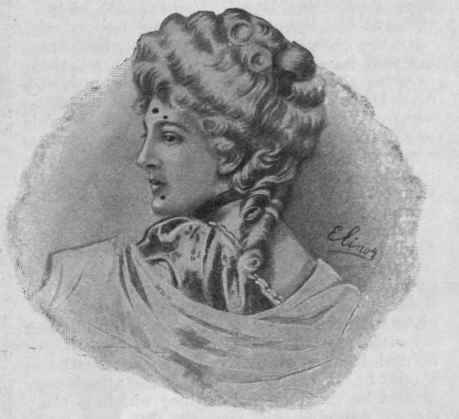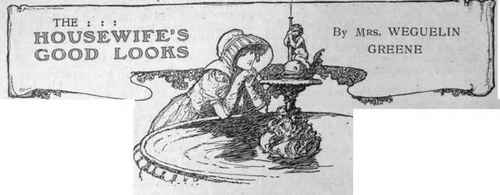The Story Of The Fatc1. Part 2
Description
This section is from "Every Woman's Encyclopaedia". Also available from Amazon: Every Woman's Encyclopaedia.
The Story Of The Fatc1. Part 2
In one drawing a plump and high-born amateur Thespian is held up to ridicule in the act of placing patches upon her face. This form of comment was admired in the late eighteenth century, and, execrable as we must consider the taste which was amused by this mean and unmeasured ridicule, the historical value of the commentary is obvious, and shows the patch to be at its very lowest ebb in popular favour.
There may or may not be an authentic language of the patch. . The coquette has evolved a language of the fan, of the glove, and of flowers. It is quite reasonable to suppose, therefore, that the patch gave opportunity for something of this kind.
We can, therefore, accept as quite authoritative some old writings which have immortalised this feminine adornment into a silent but eloquent love language.
The Language Of The Patch
Many a gallant must have spent hours of painful suspense anticipating his lady's favour, evidenced by the shape or the placing of her patch. Round patches, heart, star, and crescent shaped, were employed to proclaim their wearer's mood, and women who understood the significance of the fixing of the patch were, needless to say, very careful not to cause a misunderstanding thereby.
The frivolous and light-hearted maiden whose coquettish instincts prompted her to tease and tantalise her luckless swains placed her patch near the lip - the correct corner being the left-hand side of the upper lip. The woman of deeper feelings, who meant more than a mere flirtation, indicated her serious feeling for her suitor by wearing a round or heart-shaped spot on the left-hand corner of the left eyelid. Placed just below the eye the patch showed affection only, and that no deeper feeling had yet stirred the wearer.

This arrangement of the patch was considered to betoken a woman of serious taste and pronounced individuality
The pert and laughing girl who was only thinking of amusement placed her patch on the right. cheek by the side of the nose. Another practice of the frivolous was to cut a star-shaped patch and affix it on the left side of the chin. The heart-shaped patch worn on the left cheek was a warning to would-be suitors that the hand and heart of the lady were already engaged, and that she was already married was evident when she transferred the patch to the right side of the face. The patch on the forehead showed generally that its wearer was of an intellectual turn of mind, and was not to be approached unless by those of serious mien.

In the housewife's praiseworthy efforts to play her part with success, she should bear in mind that the brightest touch is given to home when a wife preserves her own good looks. To accomplish this there is an open road for every woman to take.
The Eyes
The eyes, for instance, can be kept lustrous and free from signs of fatigue by a very simple process. Every morning for about three to five minutes they should be bathed with the coldest water procurable. Sluicing on this hardy principle tones up all the muscles about the sockets and lids, a host of delicate nerves, too, connected with the sight. When all these are vigorous the eye's move freely and retain the swift, darting action of youth. When they are feeble, lines reveal themselves about the corners, and then comes that sagging of the eyelids which mars the prettiest face.
When active duties swallow up all the daylight hours, and compel the needle to be taken up at night, strict attention should be given to the colour of globes and lampshades. Red is such a tempting hue, and gives such a festive note that one condemns it with reluctance. Green has traditions behind it as cooling to the eyes. Neither should be chosen, however, but the affections should be fixed on heliotrope, which is the colour supreme for keeping the eyes un-dimmed when the midnight oil is burnt.
Artificial light, with the exception of that given by real wax candles, is, as a rule, too yellow, hence the great service a heliotrope shade can render the housewife whose needle is busy over some belated task.
A third hint, sound as the two preceding it, is to close the eyes when engaged in any hard thinking. Every good housewife knows well that a great deal of strenuous thought goes into household organising, that all may work on lines of thrift.
Eyes should be shut, then, when there is any scheming on hand, however homely the methods to be planned ; for to keep them fixed on external objects when the thinking-cap is donned, is to weary the optic nerves for no particular end.
The Hands And now for a chat about hands.
It should console any reader in passing to our second subject to learn that more ugly hands are encouraged by idleness than are ever produced by domestic work. Not only the fat, flabby type comes of inactivity, but many another one equally unattractive.
What the hands really need to keep them shapely is variety of occupation, and plenty of intelligent treatment when employed in the rougher spheres of household activity.
If called upon, for instance, to turn culinary knowledge to account, special note should be taken of the fact that fresh air is one of the greatest needs for knuckles, palms, fingers, and wrists. Much contact with the heat of a stove enfeebles the frame of the hand. All the breezes of heaven, then, should be given it from time to time, for these will restore its vigour, and keep the ugly hollows at bay that come from weakened muscles.
Continue to:


